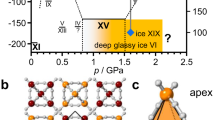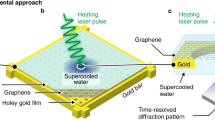Abstract
CONSIDERABLE evidence has accumulated for a highly structrued, ice-like nature of the aqueous medium in certain cellular systems, particularly in the vicinity of macromolecules such as DNA (refs 1–7). A consequence of this ordering of water molecules is that the dielectric relaxation time of the medium becomes considerably longer than the 10 ps or so found for normal water8. A correlation has been found in recent experiments between the time required for solvation of electrons in polar liquids9–13 and the dielectric relaxation time. On the basis of this a longer lifetime for unsolvated (‘dry’14) electrons in biological systems, than the few picoseconds15,16 found in normal aqueous media, would be expected. An extended lifetime for dry electrons, particularly if coupled with a high electron mobility, would increase the probability of this species playing a role in cellular radiation damage, as has recently been suggested17, and also in intra- and inter-molecular charge transport processes in biological systems. To obtain an insight into the properties of electrons in a structured aqueous medium, we have studied the conductivity change resulting from nanosecond pulse ionisation (irradiation) of ice. We outline here some conclusions we have reached concerning the yield and mobility of excess electrons as well as the processes of electron trapping and ion recombination in this medium.
This is a preview of subscription content, access via your institution
Access options
Subscribe to this journal
Receive 51 print issues and online access
$199.00 per year
only $3.90 per issue
Buy this article
- Purchase on Springer Link
- Instant access to full article PDF
Prices may be subject to local taxes which are calculated during checkout
Similar content being viewed by others
References
Tait, M. J. & Franks, F. Nature 230, 91–94 (1971).
Eagland, D. in Water, a comprehensive treatise (ed. Franks, F.) 4, (Plenum, London, 1975).
Migchelsen, C., Berendsen, H. J. C. & Rupprect, A. J. molec. Biol. 37, 235–237 (1968).
Thompson, R. T., Knipsel, R. R. & Pintar, M. M. Chem. Phys. Lett. 22, 335–337 (1973).
Lewin, S. J. theoret. Biol. 17, 181–212 (1967).
Jacobson, B. Nature 172, 666–667 (1953).
Ling, N. G. Water and Aqueous Solutions (ed. Home, R. A.) 663–700 (Inter- science, New York, 1972).
Hill, N. E., Vaughan, W. E., Price, A. H. & Davies, M. Dielectric Properties and Molecular Behaviour, 344 (Van Nostrand, London, 1969).
Baxendale, J. H. & Sharpe, P. H. G. Int. J. Radiat. phys. Chem. 8, 621–624 (1976).
Baxendale, J. H. & Wardman, P. JCS Faraday Trans. I, 69, 584–594 (1973).
Kenney-Wallace, G. A. & Jonah, C. D. Chem. Phys. Lett. 47, 362–366 (1977).
Kenney-Wallace, G. A. Canad. J. Chem. 55, 2009–2015 (1977).
Hunt, J. W. & Chase, W. J. Canad. J. Chem. 55, 2080–2085 (1977).
Hamill, W. H. J. phys. Chem. 73, 1341–1347 (1969).
Chase, W. J. & Hunt, J. W. J. phys. Chem. 79, 2835–2845 (1975).
Rentzepis, P. M. & Jones, R. P. J. chem. Phys. 59, 766–773 (1973).
Bakale, G. & Gregg, E. C. Br. J. Cancer (in the press).
Infelta, P. P., de Haas, M. P. & Warman, J. M. Radiat. phys. Chem. 10, 353–865 (1977).
Eckener, U., Helmreich, D. & Engelhardt, H. Physics and Chemistry of Ice, (eds Whalley, E. Jones, S. J. & Gold, L. W. 242–245 (The Royal Society of Canada, 1973).
de Haas, M. P. thesis, Univ. Leiden (1977).
Allen, A. O., de Haas, M. P. & Hummel, A. J. chem. Phys. 64, 2587–2592 (1976).
Seager, C. H. & Emin, D. Phys. Rev. B. 2, 3421–3431 (1970).
Eisele, I. & Kevan, L. J. chem. Phys. 55, 5407–5409 (1971).
Mogensen, O. A. J. chem. Phys. 60, 998–1004 (1973).
Debye, P. Trans. electrochem. Soc. 82, 265–272 (1942).
Hobbs, P. V. Ice Physics 90 (Clarendon, Oxford, 1974).
Hobbs, P. V. Ice Physics 26 (Clarendon, Oxford, 1974).
Bertie, J. E., Labbe, H. J. & Whalley, E. J. chem. Phys. 50, 4501–4520 (1969).
Mogensen, O. E. & Eldrup, M. Phys. Lett. 60 A, 325–326 (1977).
Eldrup, M. J. chem. Phys. 64, 5283–5290 (1976).
Bilgram, J. H., Roos, J. & Gränicher, H. Z. Physik 23 B, 1–9 (1976).
Eiben, K. & Taub, I. A. Nature 216, 782–783 (1976).
Taub, I. A. & Eiben, K. J. chem. Phys. 49, 2499 (1968).
Nilsson, G., Christensen, H., Pagsberg, P. & Nielsen, S. O. J. phys. Chem. 76, 1000–1008 (1972).
Buxton, G. V., Gillis, H. A. & Klassen, N. V. Canad. J. Chem. 55, 2385–2395 (1977).
Author information
Authors and Affiliations
Rights and permissions
About this article
Cite this article
VERBERNE, J., LOMAN, H., WARMAN, J. et al. Excess electrons in ice. Nature 272, 343–344 (1978). https://doi.org/10.1038/272343a0
Received:
Accepted:
Published:
Issue Date:
DOI: https://doi.org/10.1038/272343a0
Comments
By submitting a comment you agree to abide by our Terms and Community Guidelines. If you find something abusive or that does not comply with our terms or guidelines please flag it as inappropriate.



